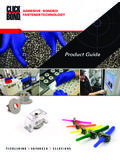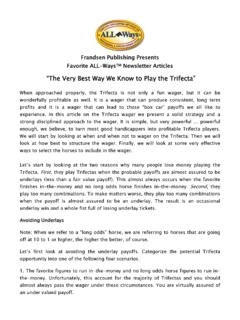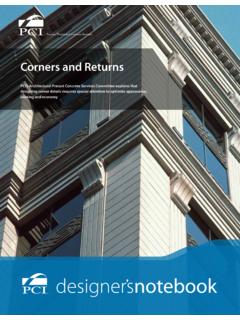Transcription of Specifier’s Guide to Interior Concrete Floors
1 specifier s Guide to Interior Concrete FloorsCONCRETE floor CONTRACTORS ASSOCIATION OF CANADA 2016 specifier s Guide to Interior Concrete FloorsCONCRETE floor CONTRACTORS ASSOCIATION OF CANADA 2014 Contents XNote: to jump to a page or section, click on the item above. Also, to jump to a section from a regular page, roll your cursor over the right side margin, to access the tabs as 2 Design Considerations 3 The Concrete floor Specification: Section 03 35 00 4 Canadian Standards 4 Specification of Responsibilities 4 Pre-qualification 6 Divided-Source pre-qualification: 7 Single-Source pre-qualification: 8 Materials Pre-qualification 8 Sustainability 8 Concrete Mixes for Floors 9 Drying Time for Applied Finishes 13 Vapour Permeability & Vapour Retarders 14 Granular Bases 14 floor Joints 15 Construction Joints 15 Isolation Joints 15 Contraction Joints (control or sawcut joints)
2 16 Reinforcing for Slabs on Grade 17 Unreinforced Plain Concrete Floors 17 Micro Synthetic Fibres 18 Welded Wire Mesh 18 Rebar Reinforcing 19 Steel Fibre Reinforcing 20 Macro Synthetic Fibres 22 Concrete floor Tolerances 22 Thickness Tolerances 22 Surface Tolerances 23 Surface Finishes 26 Mock-Up Samples 27 Wear Resistance & Colouration 27 Wear & Abrasion Resistance 28 Acid Stains & Dyes 29 Integral Colouring 29 Curing 30 Joint Fillers 30 Sealers, Coatings & Densifiers 31 floor Sealers & Coatings 31 Penetrating Densifiers 32 Special Concrete floor Surfaces 33 Exposed Concrete as an Architectural Finish 33 Ice Rink Slabs 33 Bonded Concrete Toppings 34 Superflat Floors 35 CFCA Concrete floor Warranties 35 Construction 37 Pre-construction Meetings 38 Inspection & Testing 39 Materials Substitutions 40 Corrective & Preventative Action 40 Standard Specification 41 Reference Documents 51 Definitions 52 Standard Concrete Finishes 54 Architectural Finish Examples 56 Online Publications 60 Other Reference Documents 61 Contact Information 62 Concrete floor CONTRACTORS ASSOCIATION OF CANADA2 specifier s GuideForewordConcrete floor trade work in Canada currently varies significantly in quality due to divided responsibilities, poor understanding of national standards.
3 Inconsistent compliance with specification requirements, inadequate technical knowledge, variable field skills, lack of inspection, and the absence of any formal requirement to commit to Concrete floor Contractors Association (CFCA) was founded in Toronto in 1972 by leading members of the Concrete floor trade in an effort to organize, standardize, and promote high quality Concrete flooring. Since its creation, CFCA members have evolved from their cement finishing roots to include all aspects of Concrete floor construction. Modern CFCA trade contractors offer complete Concrete floor solutions to meet any is the intent of this Guide to assist architects and engineers in defining Concrete Floors in standardized terms, such that the industry can consistently meet the needs of its clients. This document also aims to further define the responsibilities for CFCA members in order to produce high quality work.
4 While this Guide provides general recommendations, it remains the responsibility of the designer to consider and specify Concrete Floors that satisfy the particular needs of their clients. This Guide is intended for use by professional architects, engineers, Interior designers and specification writers it is not a substitute for such professional advice. The CFCA extends its full assistance in supporting its specifiers in conjunction with the information in this Guide . Although there are many available sources of information on Concrete flooring, this remains the only Guide in Canada that has been written by Concrete floor trade contractors for specifiers. The standard Concrete floor specification included in this Guide has added commentary which we hope you will find informative and is through the continuing support of specifiers, that the vision of consistent, high quality results are achieved.
5 Specifiers who prequalify members of the CFCA facilitate our continuing efforts to promote standardization and quality within the Concrete floor industry across feedback to this Guide is welcome as it helps the industry evolve to meet the demands of building owners, specifiers and call, e-mail, or visit us online at Note: The use of the term Specifiers , in the context of this document, is synonymous with architects, engineers, Interior designers and specification writers as representatives of building s Guide to Interior Concrete FloorsCONCRETE floor CONTRACTORS ASSOCIATION OF CANADA 2014 Design ConsiderationsDesign ConsiderationsCONCRETE floor CONTRACTORS ASSOCIATION OF CANADA4 Design Considerations The Concrete floor Specification: Section 03 35 00 Specifications commonly divide Concrete floor requirements into three Concrete sections; Cast-in-place Concrete , Concrete Finishing , and Concrete floor Hardening.
6 Conflicts often occur due to the variation of the requirements of each section, leading to problems and to potentially lower quality results. A separate Concrete floor specification section is required in Division 3 to remedy this. Included in this Guide is a Concrete floor specification section template for Concrete Floors on grade, metal deck and bonded Concrete toppings. Specifiers are encouraged to adopt this specification section as a template for high-quality Concrete floor is essential that the required Concrete floor tolerances from Division 9 be placed within the Concrete floor specification section 03 35 00. Tolerances listed in other specification divisions are not generally referred to by Concrete floor contractors when tendering or constructing Concrete editable version of the specification is available online: Canadian StandardsAll specifications must reference compliance with the national Canadian standard CSA Materials and Methods of Concrete Construction.
7 This defines several mandatory requirements which are essential for obtaining high-quality results. All CFCA members understand and comply with these standard requirements. Other CSA standards for reference: CSA 14 Test Methods and Standard Practices for Concrete CSA 14 Design of Concrete Structures CSA S413 14 Parking Structures Specifiers must not reference guides within specifications, such as ACI 302 they do not stipulate mandatory requirements for compliance, but do offer a number of alternatives to assist in decision making. Specification of ResponsibilitiesThere are two approaches to constructing Concrete Floors . The first being the traditional Divided-Source approach, where the Concrete floor contractor performs only a part of the work, such as placing and finishing. The second is the Single-Source full responsibility approach, where the Concrete floor contractor organizes, plans and supplies all labour and Concrete materials to construct the entire Concrete floor assembly.
8 Concrete floor CONTRACTORS ASSOCIATION OF CANADA5 Design Considerations YOURFLOORG eneralContractorMaterialssuppliers(multi ple)ReinforcingcontractorFormingcontract orCaulkingcontractorPolishingcontractorC oncreteplacing & finishingcontractorReady-mixedconcretepr oducerSawingcontractorFloor sealingcontractorEarthworkscontractorFig ure 1: Divided-Source ApproachFor the traditional Divided-Source approach to constructing Concrete Floors , several unrelated parties come together on the day of the Concrete placement, with potentially varying commitments to quality and coordinated efforts. The division of responsibility, or the supply of materials and workmanship by these parties can promote non-conformance, material substitutions, omissions, and ultimately low-quality results. The divided scope approach embraces a philosophy of doing what you are told , be that correct or otherwise.
9 Concrete floorcontractorFormingReinforcingPlacing FinishingJointingCuring & sealingCaulkingConcrete polishingMaterialManagement: Concrete mixes Surface hardeners Sealers Joint fillers Figure 2: Single-Source Full Responsibility ApproachCONCRETE floor CONTRACTORS ASSOCIATION OF CANADA6 Design ConsiderationsFor the Single-Source approach, all Concrete floor materials and workmanship are coordinated by a qualified Concrete floor contractor, in order to produce optimal results. While the basis for this approach remains prescriptive, inclusion of the full scope of Concrete floor assembly under the care of a knowledgeable and experienced Concrete floor contractor also adds an element of performance the highest quality results, all materials and workmanship should be coordinated and managed by a single competent source an experienced and knowledgeable Concrete floor trade contractor.
10 To achieve consistent, higher quality results, the Concrete floor contractor needs to embrace responsibility for the complete orchestration of all materials and workmanship. Use traditional divided scope of work & responsibilitiesPrequalification: desireableDo I require a higher quality Concrete floor ? are the technical or architectural requirements important to my client ? unique or difficult applications such as architectural finishes, rink slabs, bonded toppingsUse single source full responsibility approachPrequalification: suspended slabs or Floors with applied finishesNoYesFigure 3: Responsibilities Decision TreePre-qualificationWhile much time is spent assessing materials in specifications, less time is spent pre-qualifying workmanship or defining the responsibilities of various parties to construct a Concrete floor successfully. The combination of poor workmanship and good materials is problematic from a quality and performance perspective.







